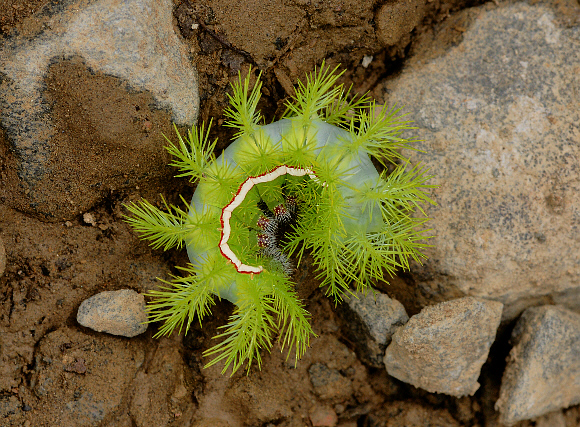 Automeris liberia, Manu cloudforest, 900m, Peru – Adrian Hoskins
Automeris liberia, Manu cloudforest, 900m, Peru – Adrian Hoskins
Introduction
The genus Automeris contains about 260 species.Automeris liberia occurs in Ecuador and Peru.
Habitats
This species is found in rainforest and cloudforest habitats at altitudes between about 400-1500m.
Lifecycle
The caterpillars of all moths in the subfamily Hemileucinae have stinging spines. One particular species Lonomia obliqua, has well camouflaged spiked caterpillars which can be found clustered in groups of up to 100 on the trunks of trees in Amazonia. There have been many incidents where people have touched or unwittingly rubbed against groups of these larvae. The effects of a dose from multiple larvae can be very dangerous, including massive intercranial haemorrhaging and kidney failure.
Lonomia larvae are a frequent cause of death in southern Brazil – 354 people died between 1989 and 2005. The fatality rate is about 1.7% – roughly equivalent to that of rattlesnake bites. Fortunately Automeris larvae are non-lethal, but many can produce a very painful sting.
The larvae of most species when fully grown are bright green, marked laterally with dashes or stripes of red ( or orange ) and white. Along the back and sides are rows of multi-branched stinging spines, each like a miniature Xmas tree.
The larvae of most Automeris species are polyphagous – e.g. the known foodplants of Automeris io include such unrelated pabula as Salix, Quercus, Hibiscus, Azalea, Prunus, Trifolium and Euterpe. When young the larvae feed gregariously, but they gradually disperse and become solitary by the final instar. Automeris liberia is known to feed in the wild on Salix, Quercus and Gleditsia.
Adult
The numerous Automeris species vary in pattern and colouration. Some have yellowish forewings, but most are brown marked with dark post median lines, and when at rest resemble dead leaves. Others have greyish forewings mottled or marbled with darker tones, and provide a convincing camouflage when they are at rest on tree trunks. The hindwings are usually much brighter in colour, being creamy or bright yellow in most species, marked with red or orange. There is always a pair of prominent false eyes, which vary in size from species to species.
If the moths are disturbed they immediately drop to the ground and uncover their hindwings to reveal the startling eye-spots. At the same time they usually arch their abdomens, and twitch violently, thrusting the hindwings and their eye-spots forward in a series of rhythmical movements. The effect on humans is usually to recoil in shock, and no doubt birds react in a similar manner, and in many cases are so startled or scared that the moths escape being eaten.

